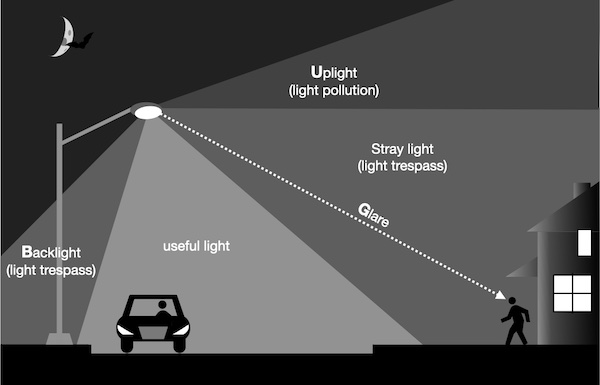By Galen Gisler
We have a new lighting ordinance in Los Alamos!
Nearly two years ago, the Jemez Mountains Night Sky Coalition (consisting of PEEC, the Pajarito Astronomers, Bandelier, Valles Caldera, Los Luceros, and neighboring communities) proposed to develop a new lighting ordinance for Los Alamos County. We published the draft we developed in the PEEC Dark Sky blog pages, which can be viewed here.
We submitted that draft to Dekker/Perich/Sabbatini (DPS), the firm that the County hired to write the County’s new Development Code, and this was debated by the citizens’ advisory panel in sessions taking place over several months in 2021 and 2022. Eventually, DPS hired Clanton & Associates, a night-sky-friendly lighting consultant firm from Boulder, Colorado, to help with the final formulation of the lighting portion of the Development Code.
At the Regular County Council meeting on December 13th, 2022, the new Development Code, including the lighting ordinance, was passed unanimously by the Council. This is a tremendous success for night-sky advocates in our region and may support a potential application by our County to be considered a Dark Sky Community by the International Dark-Sky Association. Since Valles Caldera National Preserve is already a designated International Dark Sky Park, and Bandelier National Monument intends to apply for similar status, we are well on our way to joining other communities and parks in Northern New Mexico as a Dark Sky Corridor. Officials at Los Alamos National Laboratory are also cognizant of these developments, and it is hoped they will also join in the effort to protect the common property of our glorious dark skies.
Preserving dark skies is not just about cultural values, star-gazing, or astronomy. Overlighting the night is known to be detrimental both to human health and to the wildlife with which we share our surroundings. The natural cycles of day and night are used by animals for migration, mating, pollination, and more. Artificial light has caused disruptions to those natural cycles, contributing to population reductions in many species and even the extinction of some species. We, humans, have our own circadian rhythms; bright lighting at night causes a decrease in melatonin production, resulting in sleeplessness and lowered immune response. (For further details, see Light Pollution, the Environment, and Us)
The new lighting ordinance has most of what we’ve asked for. Notably, it has strict net site lumen limits commensurate with those in recognized Dark Sky Communities, it sets an upper limit of 2700 K for coordinated color temperature for all commercial and street lighting under County control, and requires dimming of commercial lights after business hours. The ordinance applies to all new developments and to significant changes in existing developments but requires that all commercial and county lighting come into conformance within ten years. Residential lighting is encouraged but not required to follow the guidelines in the ordinance.


LANL lights have spoiled deep sky telescope viewing from Camp May.
Valle Grande may not hold on to its Int’l Dark Sky Park status much longer because of increasing light pollution at the gate. Hunters are allowed in and out of the Preserve, but not amateur astronomers.
Now have to drive north of Ghost Ranch to enjoy dark skies of 5 years ago in Los Alamos.
Nowhere in this ordinance do I see a mechanism for enforcement. Who do you call to assess the illegal lights your neighbor has installed on his above-ground deck that light up the entire neighborhood? Who keeps track of the horrible lighting at the bank and other businesses along Rover in White Rock? If your neighbor’s illegal lights are only on at night, who is going to come from the County to measure the strength and reach of those lights? How will people with illegal lighting be convinced or coerced to change them for legal lighting? I’m all for trying to bring back and/or keep the dark skies I grew up with here; I just don’t see a way for this ordinance to make a difference without enforcement.
Enforcement is not a part of this ordinance, nor of many other similar ones. We have to go with education, from neighbor-to-neighbor, and with some help from County Staff. We are hoping to have inserts placed in utility bills to inform residents and businesses of the virtues of good outdoor lighting practices. After 10 years, when the amortization clause kicks in, businesses should by then be aware of the restrictions of the ordinanace and should have planned what needs to be done to come into compliance. But even before then, we as residents could engage with business owners and managers in the process of informing them of good lighting practices. Let’s be friendly about it, not confrontational. Point out that you can see better in the dark when the lights are not too bright and not shining in your face.
Regarding measuring lighting, I would never expect County staff to do that, especially as they typically don’t work at night. There are people in town who have access to sensitive light meters, and we may someday (not this year!) provide a mechanism for individuals to request measurements done by these (anonymous) volunteers. For the moment, just talk to your neighbors about it.